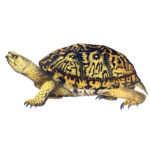One creature I haven’t seen in my backyard is the box turtle. Turtles are in decline in my mid-Atlantic region, mostly due to suburban sprawl. The box turtle’s home range is usually about 12 to 14 acres.
Box turtles are slow crawlers, extremely long lived, slow to mature, and have relatively few offspring per year.
Turtles are omnivores and will enjoy fruits, fungi, veggies, greens, mollusks, worms and insects. From research with wild turtles, we know they eat plants for almost half the diet and animal foods for a little bit over half the diet. They are opportunistic feeders, willing to eat almost anything edible that they find.
Turtles are cold-blooded. They thermo-regulate by basking in the sun to warm up and seeking a moist shady place when they are too hot.
There are six existing subspecies. It is found throughout the eastern United States and Mexico. The box turtle has a distinctive hinged lowered shell (the box) that allows it to completely enclose itself. Its upper jaw is long and curved.
The female box turtle lays hundreds of eggs during her lifetime, but only 2 or 3 of her hatchlings grow to adulthood. She can carry sperm for up to four years, laying clutches of fertilized eggs for several seasons without mating. The eggs are placed in a shallow depression in soft earth that she digs with her back legs. The eggs hatch in late summer, but the young usually stay hidden in their nest through the winter. The babies feed off the yolk preserves and come out in spring, almost a year after the eggs are laid. Hatchlings are about an inch in size, with a plain, unpatterned, flexible shell.
Male turtles have a bright red eye. Females have brown, yellow, or faded red. They can live more than 100 years.
Predators
- Raccoons love to eat baby turtle hatchlings.
- Automobiles smash many turtles crossing the road.
- Pet traders kidnap the turtles to sell.
Create a Turtle Friendly Garden
- Plant fruiting shrubs like grapes, cherries, mulberries, and blackberries.
- Designate a wooded area where you can leave natural leaf litter to turn to mulch where the turtles can forage for food, spend the night safely, and overwinter.
- Create a moist or swampy depression for turtles to cool themselves on a hot day.
- Pile up some brush where turtles can nest and rest.
- Plant a vegetable garden. Turtles will be happy to raid it.




TrackBack URL
https://www.karenfurst.com/blog/common-box-turtle-terrapene-carolina/trackback/